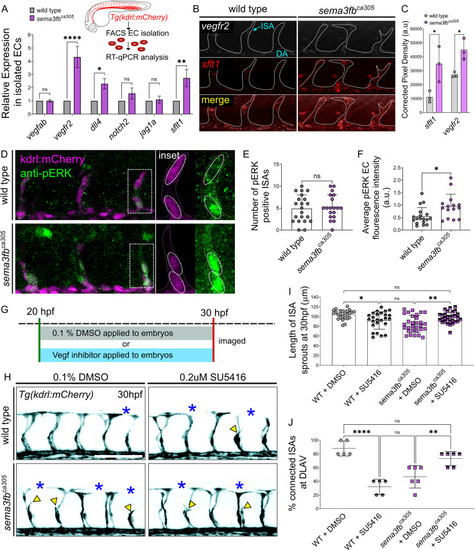- Title
-
Endothelial Semaphorin 3fb regulates Vegf pathway-mediated angiogenic sprouting
- Authors
- Watterston, C., Halabi, R., McFarlane, S., Childs, S.J.
- Source
- Full text @ PLoS Genet.
|
A) Lateral view of sema3fb expression at 30hpf by ISH. Inset shows expression in the dorsal aorta (DA) and intersegmental arteries (ISAs). B) Schematic representation of the zebrafish vasculature at 30 hpf. Inset: The ISAs sprout from the DA and connect to form the Dorsal Longitudinal Anastomotic Vessel (DLAV) by 30 hpf. C-E) Lateral confocal images of the trunk vasculature (black) of 30 hpf (C) wild type sibling (sib), (D) heterozygous (het) sema3fbca305/+ and (E) homozygous (hom) sema3fbca305 mutants. Gaps in the DLAV (blue asterisks) and truncated ISA sprouts (yellow arrowhead) are noted. Abbreviations: DA (Dorsal Aorta), and PCV (Posterior Cardinal Vein). Anterior, left; Dorsal, up. Scale bar, 100 μm. F) ISA Sprout length at 30 hpf in wild type (WT) sibs (mean length of 106±10 μm), het sema3fbca305/+ (92±19μm), and hom sema3fbca305 (91±18μm), ****p<0.0001. G) Percentage of ISA sprouts connecting to form DLAV at 30 hpf. WT sib (mean 83% connected), het sema3fbca305/+ (50% connected) and hom sema3fbca305 (42% connected), ****p<0.0001. H) Quantification of the cross-sectional diameter of ISA sprout at the level of the horizontal myoseptum (HM; dashed red line). WT sib (mean diameter of 6.9±2 μm), het sema3fbca305/+ (8.5±2.7 μm), and hom sema3fbca305 (9.2±2.9 μm)., **p<0.0016 and ***p = 0.0002. F-G) N = 3; WT sib = 11 embryos (n = 86 ISAs), het sema3fbca305/+ = 22 embryos (n = 163 ISAs), and hom sema3fbca305 = 9 embryos (n = 75 ISAs), 2-Way ANOVA Tukey’s multiple comparisons test. Error bars = ±SD. |
|
A) Lateral confocal time-lapse images from 25–29 hpf double transgenic Tg(kdrl:mCherry;fli1a:nEGFP) endothelial cells (magenta) and nuclei (white). The location of the horizontal myoseptum (green dashed line) and DLAV (blue dashed line) are noted to highlight ISA growth over time. Scale bar, 50 μm. B) Average ISA Sprout Length at 30-minute intervals from 25–29 hpf: WT vs |
|
A) Lateral images of the trunk vasculature with mosaic endothelial expression of the transgene fli1ep: Lifeact-EGFP highlighting actin (green) and endothelial cytoplasm using Tg(kdrl:mCherry; white) in ISAs at 30 hpf. DLAV gaps (blue asterisks) and truncated ISA sprouts (yellow arrowheads) are marked. Inset shows an enlarged view of single ISAs with Lifeact-EGFP expression that have reached the level of DLAV at 30hpf. Scale bar, 100 μm. B) Representative still images from time-lapse imaging from 28–30 hpf. Enlarged still images of stage-matched embryos with mosaic Lifeact-EGFP (green) in endothelial cells spanning the ISA and reaching the level of the DLAV by 28 hpf in both wild type and sema3fbca305 embryo. Endothelial cytoplasm is shown in red Tg(kdrl:mCherry). White arrowheads indicate filopodia present in connecting ISA sprouts within the boxed regions below the DLAV. C) Quantification of number Lifeact-EGFP positive filopodia on ISAs from 28–30 hpf from embryos of the indicated genotypes. N = 3: WT (14 EGFP positive ISAs/ 30 ISAs total, 6 embryos, mean of 4 filopodia/ISA) and homozygous sema3fbca305 (18 EGFP positive ISAs/35s ISAs total, 7 embryos, mean of 7 filopodia/ISA). Unpaired t-test with Welch’s correction,*p = 0.03 and ***p = 0.0002. Error bars = ±SD. |
|
A) RT-qPCR analysis of key endothelial markers in wild type and |
|
Sema3fb is expressed by endothelial cells during angiogenic sprout formation and acts through an autocrine mechanism to suppress Vegfr2 expression and maintain endothelial cell dynamics via controlling Dll4 expression and Notch signaling in addition to modulation of pERK. Loss of |





